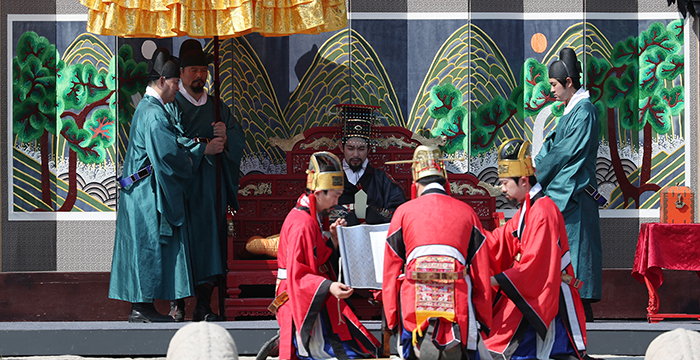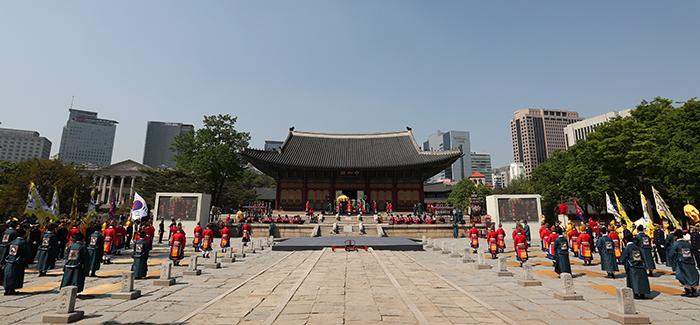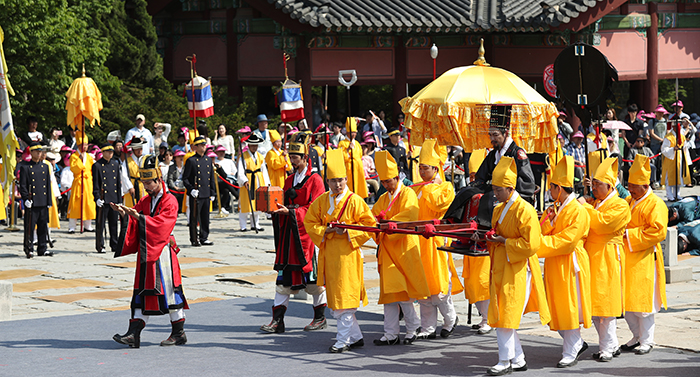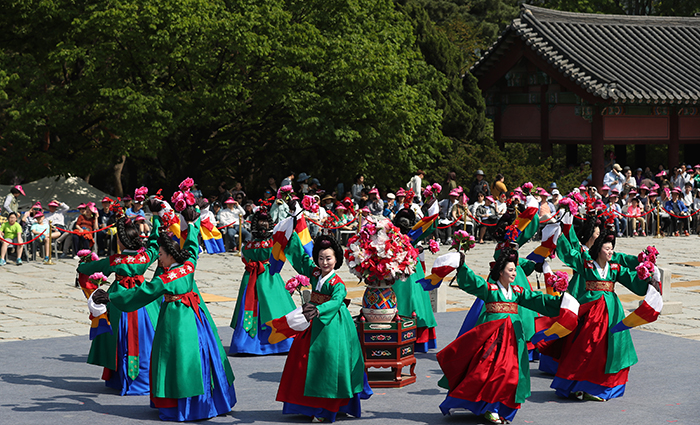
During a reenactment of Emperor Gojong's coronation ceremony, in Deoksugung Palace's Junghwajeon Hall on May 1, a group of government officials (in red) present the jinpyomun (진표문, 進表文) scrolls that contain congratulatory messages to the emperor seated on the throne.
By Jeon Han, Kim Eun-young and Lee Hana
Photos = Jeon Han
May 1, 2017 | Seoul
Gwangmu Wonnyeon (광무 원년, 光武 元年) is the name given to the year 1897. It was the Year of the Red Rooster and the first year of the Korean Empire.
When King Gojong (1825-1919, r. 1863-1907), Joseon's 26th monarch, proclaimed the founding of the Korean Empire, he christened the era "Gwangmu" on Aug. 14, 1897, a name that combines the characters for "light" and "militarism."
According to book 35 of the historical records from Gojong's 34th year of reign, the "Annals of the Joseon Dynasty," Gojong announced to his officials that, "The new era has thus been named, and on Aug. 16 -- an auspicious day chosen by the authorities -- we will carry out a grand ceremony to issue a royal proclamation."
When asked why he chose to name the era thusly, Gojong replied, "It is to build trust across the nation." This trust was to be the foundation of the newly established Korean Empire.
As planned, King Gojong issued the royal proclamation to his people and exactly 58 days later took the throne as emperor on Oct. 12, 1897.
On this day, Emperor Gojong sat on a seat made of gold, and wore the garments of the crowned emperor, but he declined to take hold of the royal seal two to three times over. Finally, he accepted the bows from his officials. The officials then performed a congratulatory ritual before the emperor. It included the sammudo (삼무도, 三舞蹈), the hitting of the knees with the hands three times, the samgodu (삼고두, 三叩頭), the bowing of the head three times, and three chants of, "Sanhomanse" (산호만세, 山呼萬世), meaning, "Long live the emperor."
The reason why Gojong hesitated to take the royal seal is recorded in the annals on Oct. 13 that same year. The records show a glimpse into Gojong's thought process as he proclaimed the Korean Empire.
According to a series of records written by Kim Yeong Su, a royal counsel, Gojong said that, "Being crowned the king was the will of the Heavens, but becoming emperor was the will of my people."

The national flag catches the breeze during a reenactment of Emperor Gojong's coronation ceremony, in Deoksugung Palace's Junghwajeon Hall on May 1. According to a newspaper article from Oct. 14, 1897, "The Taegeuk flag was raised in front of the emperor's carriage."
Fast-forward 120 years and the second Year of the Red Rooster since Gojong's coronation arrived in 2017.
In commemoration, Emperor Gojong's coronation ceremony was reenacted on the same exact spot it was held over a century ago: in Deoksugung Palace's Junghwajeon Hall on May 1, 2017.
The ceremony was performed according to the instructions found in the "Daerye Uigwe" (대례의궤, 大禮儀軌), a tome containing details about state ceremonies from the time. Reflecting the anxiety of a country that was at the onset of being colonized, the ceremony was conducted in a grave and solemn manner. The Taegeuk flag of the Korean Empire, meanwhile, flapping in the wind in front of Seokjo Hall, seemed an apt representation of Gojong's love for his people.
"[Gojong's coronation ceremony] was reenacted once before in 2003 at Gyeongbokgung Palace, so this time is not the first," said the director of the ceremony, Ann Heejae. "It is, however, the first time for the coronation to be performed at Deoksugung Palace along with the coronation of the empress and the crown prince. This is what makes today's ceremony meaningful," she said.
In addition to the coronation of Emperor Gojong, a number of events that commemorate the 120th anniversary of the declaration of the Korean Empire are being held at Deoksugung Palace. Until May 7, visitors can drink some coffee, Gojong's favorite beverage, at the Korean Empire Cafe or watch a performance of the baekhigamu (백희가무), which features traditional songs and dancing. A reenactment of Emperor Gojong’s formal reception of diplomatic envoys and a musical concert are also on the schedule.

During a reenactment of Emperor Gojong's coronation ceremony, in Deoksugung Palace's Junghwajeon Hall on May 1, the emperor arrives at the Junghwajeon Hall in a seat carried by eight carriage bearers dressed in gold.

In celebration of Emperor Gojong's coronation, a group of dancers perform the hyangakjeongjae (향악정재) traditional dance for the crowd in front of Deoksugung Palace's Junghwajeon Hall on May 1.
hanjeon@korea.kr